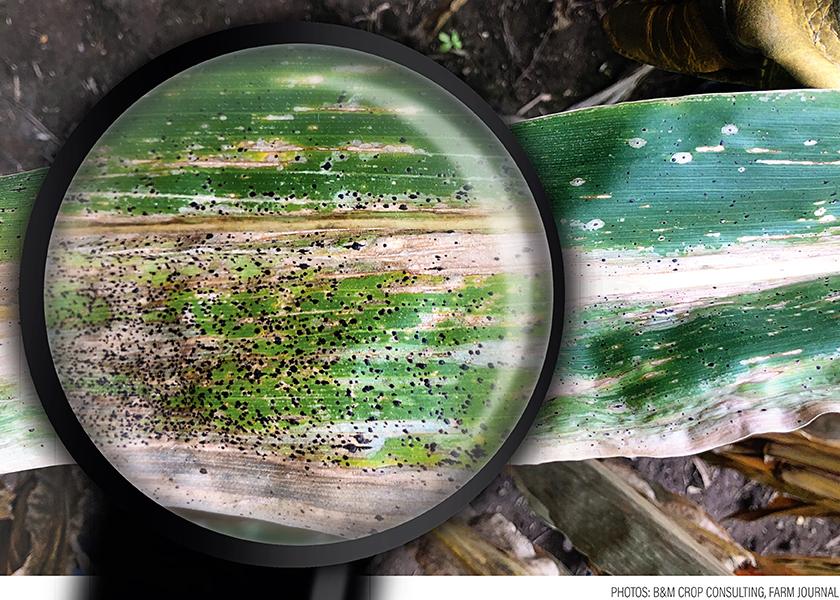How to Conquer the Cornfield Wrecking Ball of Tar Spot

A fearsome trio of high humidity, rainfall and fog helped Mother Nature deliver a tar spot gut punch to corn in many Midwest fields last summer.
“We knew it could easily take out 50 bu. an acre, but to watch it physically kill a crop in a three-week time frame, that made me step back,” says Missy Bauer, Farm Journal Associate Field Agronomist.
The initial signs she saw from the road were frost-like tinges on maturing plants.
“You’d see that the first week, then the next week it’d be a little worse, and then by the third week plants would be dead,” she recalls. “We saw a lot of corn dead right around Labor Day. It looked a lot like late October.”
Factors To Evaluate
While Bauer was taken back by the severity of the disease, she was not surprised it occurred.
“The charts were screaming at us in July as we tracked the humidity levels,” she adds. “Tracking humidity is going to be a big part of how we’ll keep an eye on it again this year.”
All hybrids have some level of susceptibility to tar spot, says Nathan Kleczewski, Growmark plant pathologist. “Do not say, ‘I planted a resistant hybrid, so I don’t have to worry about it,’” he says. “If the conditions are conducive, it still will show up.”
The Knowledge Gap
Tar spot was first confirmed in U.S. cornfields in 2015, so agronomists consider it a relatively new disease.
“There is a ginormous knowledge gap we still have to overcome,” Kleczewski says. Here are three of his recent learnings:
1. Tillage is not always effective to manage tar spot since it travels via wind. “The spores will travel at least three-quarters of a mile and probably more than that, especially when you get into flat topographies in the Midwest,” Kleczewski says. That why even if you removed corn residue from fields or rotate crops, the disease might still show up on your farm.
2. Corn at any stage is susceptible to tar spot infection when conditions are favorable. The Crop Protection Network, a consortium of Extension specialists and agronomic professionals, reports disease symptoms have been observed as early as the third-leaf (V3) growth stage.
3. The timing of infection and weather conditions can influence the disease severity and fungicide effectiveness. The disease commonly shows up later in the season, and it doesn’t always decimate the crop. However, years such as 2021 and 2018 showed its destructive nature. (Figure 1 shows tar spot location in 2021. Source: University of Wisconsin)

Start scouting for the disease by mid-July, says Dean Malvick, University of Minnesota Extension plant pathologist.
Fungicides can be effective against the disease, he says, but application timing can be tricky because the disease has a two-to-three-week latent period. That means you might not see symptoms early, but they’ll develop and appear later.
Preventive versus curative applications
Only a little tar spot infection warrants a spray, so a preventative fungicide application is more effective than a curative application. Malvick says if you see 3% disease severity on the leaf below the ear or in the mid to upper canopy before R3, a spray is “probably a decent call.”
In general, Kleczewski tells farmers to use two modes of action to address tar spot; however, he acknowledges supply chain issues might dictate what you’re able to use.
Bauer’s suggestion for farmers with fields at a high risk is to go with a planned two-pass approach with fungicides.
“We’re still trying to figure out the exact timings, whether we’ll go with an application at a late V stage or right at tassel (VT), but it will be one of those two timings,” she says. “Then we’ll come back at R3 or R4, depending on how fields look and where the tar spot is at that point.”
In dryland corn, Bauer suggests a planned one-pass fungicide application. “But if we’re planting a hybrid that we know is a little weaker, even in dryland corn after soybeans, we will go back to a two-pass approach.”
Then it is up to Mother Nature, Bauer says. If the weather is dry or the disease shows up late in the season, tar spot is unlikely to be the monster it was in 2021.
Keep an eye on all disease issues in the field, Kleczewski says, including the more common diseases such as northern corn leaf blight or gray leaf spot. “Your scouting protocol should be thorough and work to include later visits to the field when conditions are right for tar spot,” he says.







